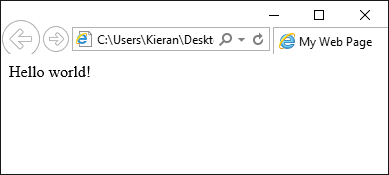What is HTML?
- HyperText Markup Language is commonly referred to as HTML.
- HTML is a markup language for describing web document (pages).
- A markup language is a set of markup tags. <HTML>, <HEAD>, <BODY>, etc.
- HTML documents are described by HTML tags.
- Each HTML tag describes different document content.
- HTML documents use the extensions .html or .htm.
You can create a simple web document using any text editor, just make sure you use the file extension .html or .htm.
Example HTML code for a simple ‘Hello World!’ web page:
<html>
<head>
<title>My Web Page</title>
</head>
<body>
<p>Hello world!</p>
</body>
</html>hello-world.html viewed in Internet Explorer:

HyperText Markup Language (HTML) is a Programming language for creating webpages. Webpages are usually viewed in a web browser. They can include writing, links, pictures, and even sound and video. HTML is used to mark and describe each of these kinds of content so the web browser can show them correctly.
HTML can also be used to add meta information to a webpage. Meta information is information about the web page. For example, the name of the person who made it. Meta information is not usually shown by web browsers.
HTML Tags (Also called HTML Elements)
HTML elements are written with a start tag, with an end tag, with the content in between:
| Start tag | Content | End tag |
|---|---|---|
| <h1> | This is a header | </h1> |
| <p> | This is a paragraph. | </p> |
| <br /> | New line of text. No content. |
